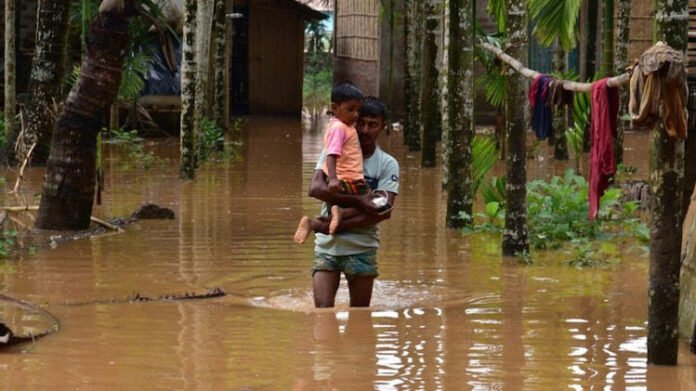Assam, known for its lush green landscapes and rich biodiversity, is currently facing the wrath of relentless monsoon rains, causing widespread devastation across the state. As heavy downpours continue to pound the region, flooding and landslides have led to loss of life, displacement of communities, and extensive damage to infrastructure and crops. The unfolding humanitarian crisis underscores the urgent need for coordinated relief efforts and long-term measures to mitigate the impact of natural disasters in Assam.
The latest bout of heavy rainfall has left a trail of destruction in its wake, with reports indicating that at least five people have lost their lives and over 40,000 people have been affected by flooding and landslides. Several districts in Assam, including Dibrugarh, Tinsukia, Golaghat, and Jorhat, have been particularly hard hit, with rivers overflowing their banks and inundating low-lying areas.
The Brahmaputra River, a lifeline for the region, is currently flowing above the danger level in many places, exacerbating the flooding situation. Thousands of homes have been submerged, forcing residents to seek shelter in relief camps set up by the government and humanitarian organizations. The displaced families are facing acute shortages of food, clean water, and other essential supplies, highlighting the urgent need for humanitarian assistance.
In addition to the human toll, the heavy rains have also caused significant damage to infrastructure, including roads, bridges, and culverts. Many areas remain cut off from the rest of the state due to landslides and flooding, hampering rescue and relief efforts. Power outages and disruptions to communication networks have further compounded the challenges faced by relief workers and affected communities.
The agricultural sector has been particularly hard hit by the heavy rains, with vast swathes of cropland inundated and crops destroyed. Farmers, already reeling from the economic impact of the COVID-19 pandemic, are now facing further losses due to the flooding. The loss of livelihoods and income opportunities threatens to deepen the existing socio-economic vulnerabilities of rural communities in Assam.
The unfolding humanitarian crisis in Assam has prompted a swift response from the state government and relief agencies, which have been working round the clock to provide assistance to affected communities. Relief camps have been set up in flood-affected areas, where displaced families are being provided with food, shelter, and medical care. Rescue teams comprising personnel from the National Disaster Response Force (NDRF) and State Disaster Response Force (SDRF) have been deployed to carry out rescue operations and evacuate stranded residents to safety.
However, the scale of the disaster and the challenges posed by ongoing heavy rainfall are testing the capacity of relief agencies to respond effectively. Limited resources, logistical constraints, and access difficulties are hindering the delivery of aid to remote and hard-to-reach areas. Moreover, the risk of waterborne diseases and other health hazards looms large in the overcrowded relief camps, necessitating urgent measures to ensure access to clean water, sanitation, and healthcare services.
As Assam grapples with the immediate impact of the heavy rains, attention is also turning to the need for long-term measures to enhance resilience and mitigate the impact of future natural disasters. This includes investments in flood control infrastructure, early warning systems, and community-based disaster preparedness initiatives. Sustainable land use planning and ecosystem conservation measures can also help to reduce the risk of flooding and landslides in vulnerable areas.
In addition, the heavy rains wreaking havoc in Assam have triggered a humanitarian crisis of immense proportions, with thousands of people affected and lives and livelihoods at risk. The response to the disaster requires a concerted effort from all stakeholders, including the government, relief agencies, civil society organizations, and the international community. By working together and prioritizing the needs of affected communities, we can help Assam recover and rebuild stronger in the face of future challenges posed by climate change and natural disasters.

